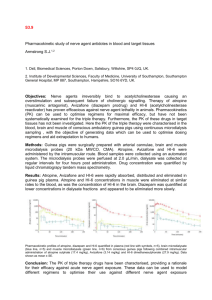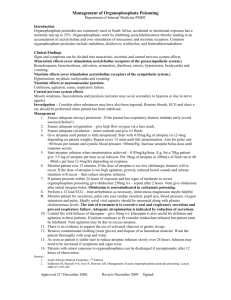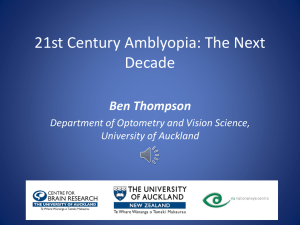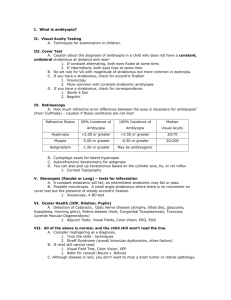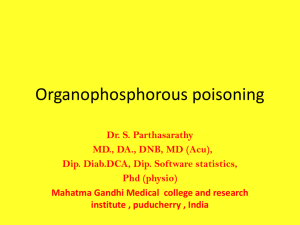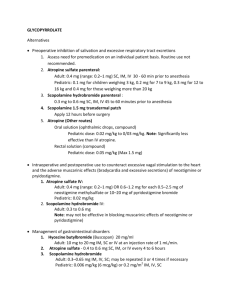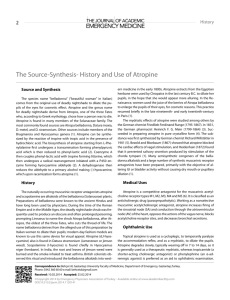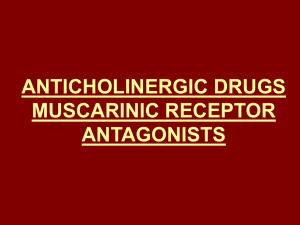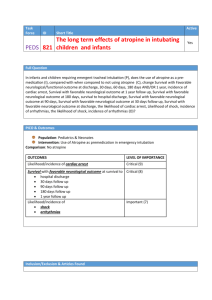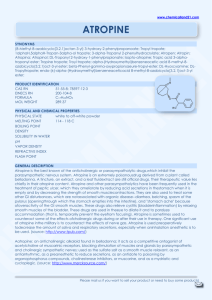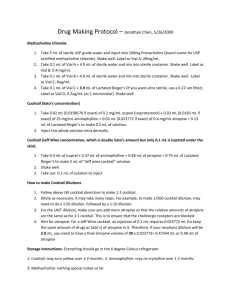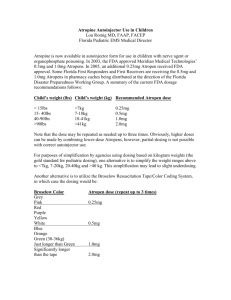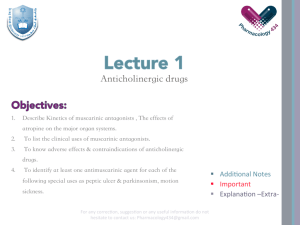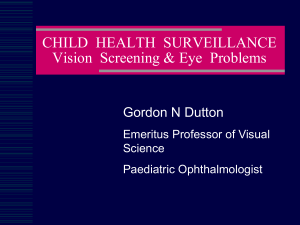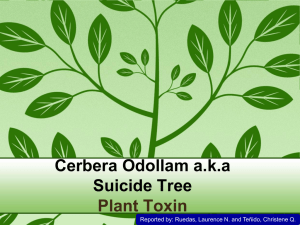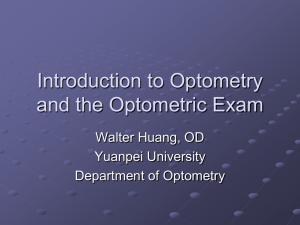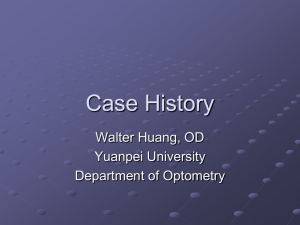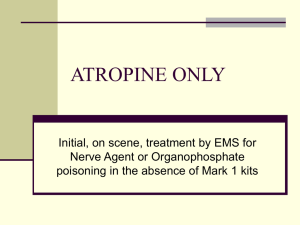Eye examination in infants, children and young adults by pediatricians
advertisement
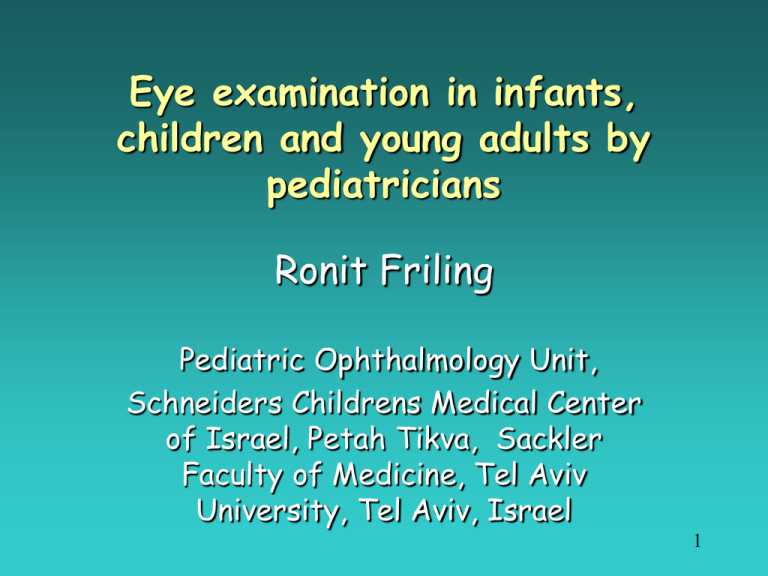
Eye examination in infants, children and young adults by pediatricians Ronit Friling Pediatric Ophthalmology Unit, Schneiders Childrens Medical Center of Israel, Petah Tikva, Sackler Faculty of Medicine, Tel Aviv University, Tel Aviv, Israel 1 Eye evaluation in the physician’s office Birth to three years • • • • • • Ocular history Vision Assessment External inspection of the eyes and lids Ocular motility assessment Pupil examination Red reflex examination 2 Ocular history • Does your child hold objects close to his or her face? • Does your child’s eyes appear straight or crossed? • Relevant family history regarding eye disorders 3 Vision Assessment Age 0-3 years To determine whether each eye can fixate on an object, maintain fixation and follow the object into various gaze positions. The assessment should be performed binocularly and then monocularly. 4 Visual Acuity Measurement Older than 3 years Picture tests such as (LEA symbols) and Allen cards can be used for children 24 years of age 5 External Examination Consists of penlight evaluation of the lids, conjunctiva, sclera, cornea and iris. Persistent discharge or tearing may be attributed to ocular infection, allergy or glaucoma but the most common cause is lacrimal duct obstruction. 6 Ocular Motility The most common cause of pseudostrabismus is prominent epicentral lid folds that cover the medial portion of the sclera on both eyes 7 Pupils The pupils should be equal, round, and reactive to light in both eyes 8 Red Reflex Test The red reflex can be used to detect opacities in the visual axis such as cataract or corneal abnormality and abnormalities of the back of the eye such as retinoblastoma or retinal detachment 9 Visual Acuity Test Snellen Acuity Cards HOTV Test The test consists of a wall chart composed of H,O,T,V The child is provided a board containing a large H,O,T,V Allen Cards Consists of 4 cards containing 7 schematic figures LEA Symbols The LH Symbol test is made of house, apple, circle, square 10 11 Amblyopia 12 Amblyopia The most common cause of monocular visual impairment in children A substandard correct visual acuity without evidence of organic eye disease Prevalence 2-2.5% in general population 13 Causes • Strabismus • Anisometropia • Visual deprivation 14 Compliance • 49% - 87% • Skin imitation • Social reasons 15 Pharmocologic Penalization • Instillation of a long acting topic cycloplegic agent (atropine) into the sound eye • Prevents accommodation • Blurring the sound eye at near fixation 16 • Penalization has been advocated only for mild and moderate amblyopia 6/18 or better • Because the blurring effect on the sound eye may be insufficient when visual acuity in the amblyopic eye is worse that 6/18 17 419 Patients 215 - Patching group 204 - Atropine group 18 Patching Group • 6 hours 43% of patients 8 hours 30% of patients • 10 hours 7% of patients • 12 hours 20% of patients Atropine Group • A drop of atropine per day 19 Results on VA in the amblyopic eye • Improvement in VA from base line in both patching and atropine groups 20 Results (cont) • Mean change in V.a. from baseline • 3.16 lines - patching group • 2.84 lines - atropine group 21 VA in the sound eye • At six-month examination • VA in the sound eye was decreased from baseline by 1 line • 7% - patching group • 15% atropine group 22 Side effects • Patch - skin irritation • Atropine - light sensitivity 18% • Lid - irritation 4% 23 Treatment • Encouragement of visual development making the patient use the amblyopic eye by reducing the visual stimulation of the fellow eye 24 Success rates of penalization therapy Optical Atropine 65% - 93% 74% - 89% 25 Criteria for combined optical atropine penalization treatment (COAT) • Lack of compliance with conventional full-time total occlusion • Failed to show an expected improvement (doubling in VA) after apparent compliance 26 Criteria for COAT • A hypermetropic refractive error of at least 1,75D in the fellow eye (the eye to be penalized) • The prescription for the fellow eye was replaced with a plano lens 27 Follow-up • Treatment was continued until the VA in the amblyopic eye was either equal to that of the fellow eye or had not improved 28 Pharmacologic penalization • Ease of administration • Reliable assessment of compliance • Relative cheapness 29 Disadvantage • Potential toxicity • Duration of effect if reverse amblyopia is detected 30 Results • The mean VA in the fellow eye at the end of treatment was not significantly different from that of the commencement of treatment • The change in VA after COAT was much higher than after occlusion 31 Results (cont) • COAT for previously foiled FTO produced a success rate of 76% success is defined as doubling of VA of the amblyopic eye 32

